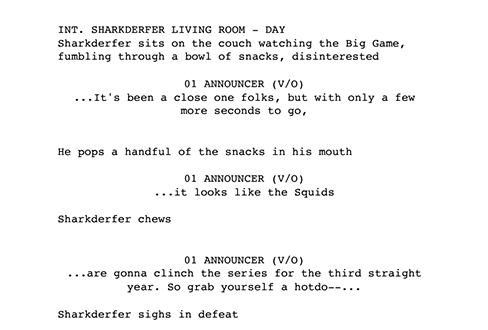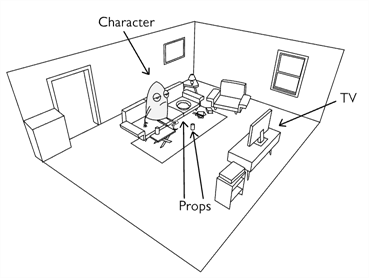T-SBCON-001-002
Technically speaking, the only thing that is absolutely needed to create a storyboard is a script. However there are a few other things that are created while the storyboard is being done, and these things can be a great asset to the storyboard artist. During the storyboarding process, the storyboard artist will work closely with the director and other team members, making suggestions and changes to the storyboard as they go.
Script
Every storyboard needs a script or a synopsis. You will also see the term 'screenplay'. A script is the written version of a project done by a screenwriter. You will encounter a script in many different types of projects such as movies, television series, video games and advertisements. It is the source of all the upcoming steps. A script usually contains the storyline, location descriptions, actions, dialogue, sound effects, etc. It contains all the information necessary for the artists to illustrate and animate the movie or series. This same script is used as a dialogue for the audio recording.

Character, Prop and Location Design
The design artist is the one who has to work on the production style, the character's look, the location's complexity, and so on. Once these designs are done and approved, the model pack is produced, containing all of the models for all these aspects.


These do not have to be finalized for the storyboarding to start, however they can help the storyboard artist greatly if created during or before the storyboarding. Storyboard and design artists can liaise with one another to help finalize their work. Location designs can draw from the angles and layout of the storyboard, and the storyboard artist can use character designs to help with expressions and acting. At this stage in the pre-production, these designs may only be rough or unapproved. The final designs and models will be used by the colour stylist and layout artist, and finally by the animator.
Audio Recording
The audio recording is also called voice recording. The script is needed for dialogue and extra sound effects. The actors will read the lines from the script and record their dialogue. These voices will be used later on for the animatic, the animation and the final production compositing.
For the storyboard artist, having the final recording is integral to the timing of the storyboard and animatic. If the final recording is not yet available, the storyboard artist can use scratch tracks which are temporary audio files acted out by the storyboard artist or a coworker. This will give an approximate understanding of the timing and beats needed in the production, even if it differs slightly from the final audio. The scratch tracks can then be replaced as the official audio is provided.
